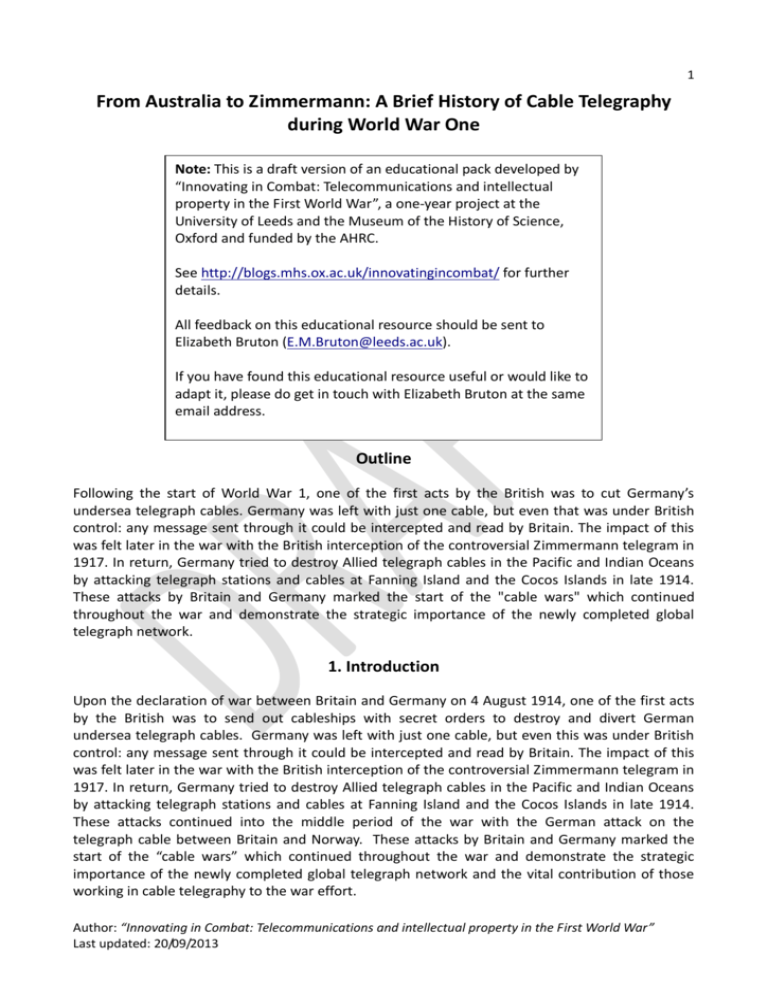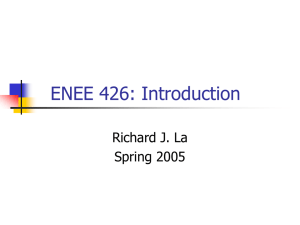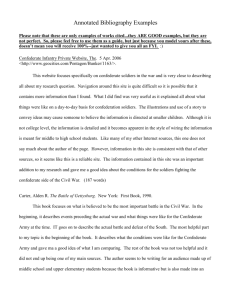From Australia to Zimmermann: A Brief History of Cable
advertisement

1 From Australia to Zimmermann: A Brief History of Cable Telegraphy during World War One Note: This is a draft version of an educational pack developed by “Innovating in Combat: Telecommunications and intellectual property in the First World War”, a one-year project at the University of Leeds and the Museum of the History of Science, Oxford and funded by the AHRC. See http://blogs.mhs.ox.ac.uk/innovatingincombat/ for further details. All feedback on this educational resource should be sent to Elizabeth Bruton (E.M.Bruton@leeds.ac.uk). If you have found this educational resource useful or would like to adapt it, please do get in touch with Elizabeth Bruton at the same email address. Outline Following the start of World War 1, one of the first acts by the British was to cut Germany’s undersea telegraph cables. Germany was left with just one cable, but even that was under British control: any message sent through it could be intercepted and read by Britain. The impact of this was felt later in the war with the British interception of the controversial Zimmermann telegram in 1917. In return, Germany tried to destroy Allied telegraph cables in the Pacific and Indian Oceans by attacking telegraph stations and cables at Fanning Island and the Cocos Islands in late 1914. These attacks by Britain and Germany marked the start of the "cable wars" which continued throughout the war and demonstrate the strategic importance of the newly completed global telegraph network. 1. Introduction Upon the declaration of war between Britain and Germany on 4 August 1914, one of the first acts by the British was to send out cableships with secret orders to destroy and divert German undersea telegraph cables. Germany was left with just one cable, but even this was under British control: any message sent through it could be intercepted and read by Britain. The impact of this was felt later in the war with the British interception of the controversial Zimmermann telegram in 1917. In return, Germany tried to destroy Allied telegraph cables in the Pacific and Indian Oceans by attacking telegraph stations and cables at Fanning Island and the Cocos Islands in late 1914. These attacks continued into the middle period of the war with the German attack on the telegraph cable between Britain and Norway. These attacks by Britain and Germany marked the start of the “cable wars” which continued throughout the war and demonstrate the strategic importance of the newly completed global telegraph network and the vital contribution of those working in cable telegraphy to the war effort. Author: “Innovating in Combat: Telecommunications and intellectual property in the First World War” Last updated: 20/09/2013 2 2. A Brief History of Electrical Telegraphy Left: William Fothergill Cooke and Charles Wheatstone's electric telegraph "needle telegraph") from 1837 now in the Science Museum. Image licensed by GNU license Via Wikimedia Commons. Right: Morse key, by Ken Owen. Image licensed via Creative Commons Attribution-NonCommercial-NoDerivs 2.0 The origins of cable telegraphy lie in early studies of electricity conducted from the 1700s onwards and the development of electrical apparatus such as galvanometers and electrical relays developed in the early 1800s. Examples of many of these items can be found at the Portchurno Telegraph Museum. By the mid to late 1830s, two different practical systems of electrical telegraphy had been developed. Cooke and Wheatstone here in Britain had developed and patented a five-needle telegraph system in 1837 and this was the world's first commercial telegraph system. Across the pond in the US, Samuel Morse and his assistant Alfred Vail (the latter is often left out of the story despite having a key role in the development of Morse code) developed an electrical telegraphy system in 1838 and developed with Vail the “Morse code” system which bears his name. This system of dots and dashes meant that only one wire was required rather than the five wires required by Cooke and Wheatstone's system. In May 1844, Morse gave the first public demonstration of his system sending the famous and widely celebrated message “What hath God wrought”. Author: “Innovating in Combat: Telecommunications and intellectual property in the First World War” Last updated: 20/09/2013 3 1891 Telegraph Cable map. Image available in the public domain. Within a few years, the idea of undersea (submarine) telegraph cables began to be explored and in 1850 the first undersea cable was laid across the English Channel between England and France by the Gutta Percha Company. Unfortunately the cable was damaged by a French fisherman who wondered what strange fish he had caught but a better cable was laid the following year. This led to flurry of submarine cables being laid with examples including those laid across the Irish Sea, the North Sea, the Mediterranean and even the Black Sea. Then came the greatest challenge: a transatlantic telegraph cable spanning the 2,500 miles separating Britain from the US. A series of attempts were made in the mid-1870s and in the 1858 the first albeit temporary telegraphic connection was made across the Atlantic. However, the cable quickly failed and it was not until July 1866 that first truly successful Atlantic cable was laid by Brunel's S.S. Great Eastern. In 1870, the first telegraph cable from Porthcurno was laid, connecting England with Bombay, India (now Mumbai). Within ten years the telegraph network from Porthcurno which was owned and managed by Eastern Telegraph Company had been extended to Indonesia, the Far East, Australia, South America and Africa. Telegraph cables from Porthcurno formed part of a network of telegraph cables stretched to all corners of the globe. The Eastern Telegraph Company grew and grew and by 1900 it operated a massive international communications network of around 100,000 miles of undersea cables. Author: “Innovating in Combat: Telecommunications and intellectual property in the First World War” Last updated: 20/09/2013 4 Map of the Submarine Telegraph between America and Europe. Image available in the public domain. News which had previously taken up to six months to reach distant parts of the world could now be relayed in a matter of hours. In 1902 the "All Red" route was completed connecting all parts of the British Empire. This telegraph network consisted of a series of cable links across the Pacific Ocean, connecting New Zealand and Australia with Vancouver and through the Trans-Canada and Atlantic lines to Europe. Submarine telegraph cables remained the only fast means of international communication for 75 years until the development of wireless telegraphy at the end of the nineteenth century. And so by 1914, a vast network of telegraph cables belonging to many different nations circled the globe. Also by 1914, Porthcurno was the main global hub of the Eastern Telegraph Company's telegraph cable network and indeed the network more generally. This network was strategically important to businesses, government, and military and a keystone in the imperial activities of many nations including Britain and Germany. 3. Outbreak of war and “Cable Wars”: cutting of cables Left: Segment of Borkum cable. Image courtesy of Porthcurno Telegraph Museum. Right: Map of the action between HMAS Sydney and SMS Emden at the Cocos Islands. Image available in the public domain. Author: “Innovating in Combat: Telecommunications and intellectual property in the First World War” Last updated: 20/09/2013 5 Upon the declaration of war between Britain and Germany (war between France, Germany and Russia having been declared two days earlier on 2 August), the British government implemented pre-war plans to cut or divert German telegraph cables. As troops were being rapidly mobilised, cableships owned by British telegraph companies were sent out with secret orders to cut German telegraph cables. This included a vessel, “John Pender”, owned by the Eastern Telegraph Company who also owned and ran Porthcurno telegraph station. The ship, named after the company's founder, purposefully cut the German telegraph cable from Borkum to Tenerife and was part of an overall strategy to cripple the German telegraph network. The British cut all but one of the German telegraph cables in the English channel leaving a sole cable, this coming being part of the “All-Red Line” and hence under British control. This meant that all German telegraph traffic could be intercepted and if decrypted, read by the British – something which would come to the fore later in the war. The British dominance of telegraphy meant that the Germans were unable to completely cripple the British telegraph network but the Germans did make two serious attempts to attack the British telegraph system. These acts confirmed the utmost importance of the vast global network of telegraph cables, overland and undersea, and resulting from this various acts of sabotage and aggression in relation to the telegraph network were committed in the early stages of the war. 3.1 Britain cuts international cables including Borkum One of the first acts of the “cable war” was the severing of the German telegraph cable between Borkum, Germany and Tenerife, part of which we have on display today. As stated previously, the ETC owned and operated cableship “John Pender” was sent out and purposefully cut a segment of the cable in the English Channel. Further to this, they also appropriated part of the cable and used this to run telegraph cables from Dunkirk to Cherbourg and Bret to Cherbourg. These acts took place between August and November 1914 and the outcome for Germany was the loss of an essential communications link to their outpost on the Atlantic island. Assorted vessels and cableships, some owned by the Eastern Telegraph Company, were chartered to assist with cable repairs and to also destroy and commandeer enemy telegraph cables. This marked the start of the “cable wars” which continued for most of the war. With the British having destroyed most of the German cable network, how did the Germans respond? The Germans did not have access to the vast fleet of cableships that Britain did through the multitude of British cable companies and was forced to take a different approach: that of attacking British telegraph stations and severing the telegraph cables there. This began with an attack on the Fanning Island telegraph station in the Pacific Ocean in September 1914 followed by a separate attack on the telegraph station on Direction Island, part of the Cocos Islands in the Indian Ocean, in November 1914. A later attack by the Germans on the telegraph cable connecting Britain and Norway also took place in July 1915. Author: “Innovating in Combat: Telecommunications and intellectual property in the First World War” Last updated: 20/09/2013 6 3.2 German attack on Fanning Island In early September 1914, two German cruisers SMS Nürnberg (later sunk at the Battle of the Falkland Islands in December 1914) and SMS Titania attacked the Eastern Telegraph Company telegraph station on Fanning Island in the Pacific Ocean. This was known as the “Fanning Raid”. The Fanning Island station formed key part of Pacific segment of “All-Red Line” and was the site for Eastern Telegraph Company's central Pacific telegraph cable relay station. In 1902, the Eastern Telegraph Company began construction of their Pacific Line which connected Bamfield, Vancouver Island with Fanning Island 3,300 miles away. At the time, this was the longest continuous telegraph cable. The Fanning Island station acted as the central Pacific relay station, passing the signal onto the Fiji relay station 2,200 miles away which itself relayed the signal to Norfolk Island and onward to New Zealand. Norfolk Island was a small island in the Pacific Ocean located between Australia, New Zealand and New Caledonia and a British colony since 1788. The Eastern Telegraph Company Pacific line connected New Zealand with Canada and through to Britain. The two German vessels which took part in the “Fanning Raid” attacked the telegraph station by pretending to be French with SMS Nürnberg sailing into Fanning flying a French flag. A German landing party was sent ashore and cut the communications cable, wrecked the cable station, and destroyed a cache of spare instruments. However, no casualties were sustained. Two weeks, communications were re-established with the assistance of a telegraphy employee Hugh Greig who dived for the severed ends of the cable and re-connected them. 3.3 German attack on Cocos Islands The Battle of the Cocos was a brief naval battle between the German light cruiser SMS Emden and the Australian light cruiser HMAS Sydney on 9 November 1914 at Direction Island, one of the small islands making up the territory of Cocos Islands in the Indian Ocean. The islands are located in the Indian Ocean approximately midway between Australia and Sri Lanka, and are southwest of Christmas Island. The telegraph and wireless station on Direction Island had been opened since 1902. Between the outbreak of war and November 1914, SMS Emden captained by Karl von Müller had taken an active and highly successful role in disrupting allied shipping and attacking shore stations in the Indian Ocean, partially through their strategic use of wireless. Von Müller gained a reputation for his chivalry and daring. As a result of their successful and disruptive activities, the Emden was actively hunted by allied warships but remained elusive until early November 1914 when they decided to attack and destroy the Eastern Telegraph Company telegraph and wireless station on Direction Island, one of the smaller islands in the Cocos Islands which had been home to a telegraph station since 1902. The crew of the Emden added a fourth smokestack and disguised themselves as British vessel HMS Yarmouth and even perfected British naval salute and cheers! On 8 November 1914, they approached the island but were observed by the station director Superintendent Dover A.G. De H. Farrant acting suspiciously and Farrant also observed that smoke was not being emitted from their fourth smokestack. Author: “Innovating in Combat: Telecommunications and intellectual property in the First World War” Last updated: 20/09/2013 7 Farrant, the station director, sent out distress signals via wireless and telegraph with the wireless distress signal being received by H.M.A.S. Melbourne, one the heavy cruisers escorting a convoy of about thirty-eight ANZAC (Australian and New Zealand) troop transports, at about 6.30am. Melbourne was about 55 miles away and sent the other Australian escort vessel, the light cruiser H.M.A.S. Sydney, to attack the Emden. Meanwhile, the landing party of the Emden had attacked the station, destroying the telegraph and wireless apparatus as well as the wireless antenna, and cutting one of the telegraph cables. The axe we have on display here was used in the attack and left behind. In destroying the wireless antenna, the landing party was asked by crew not destroy tennis courts but accidentally destroyed a cache of whiskey instead! The Emden was able to intercept the wireless messages between the Melbourne and the Sydney and so recalled the landing party (which had gone ashore and successfully disabled the station but not before distress signals had been sent) and prepared for attack. However, the German landing party were not able to make it back in time to the Emden. The Sydney arrived at approximately 9.30am and was immediately fired upon by the Emden whose guns had longer range than those of the Sydney. The Emden was unable to inflict sufficient damage and soon the Sydney came within range of her guns and began to fire, hitting and severely damaging the Emden and killing and injuring a number of her crew. The damage was sufficient that the vessel was in danger of being sunk and so her captain choose to beach on North Keeling Island rather than sink and lose all her crew. The Emden beached at approximately 11.20am and the Sydney headed off in pursuit of her supporting colliery which they found in the process of scuttling. Returning to the Emden, it was observed that their battle ensign was still flying, generally a sign that a ship intends to continue fighting. The Sydney attempted to make contact but could not and so fired upon the Emden resulting in the death of twenty members of her crew. Immediately the Germans lowered their battle ensign and raised a white flag of surrender. The following day, the Sydney gathered up the remainder of the injured crew and returned to the convoy. The remaining crew of the Emden were eventually sent to P.O.W. camp. Meanwhile the landing party on Direction Island prepared to defend the island but upon observing the fate of the Emden instead commandeered a boat and under the cover of darkness escaped and sailed to Sumatra without a single chart. After a perilous journey by ship and overland the landing party arrived in Constantinople, reported to the German admiral stationed there, then continued on to Germany itself. The entire journey took eighteen months. In recognition of their courage and tenacity and as a signal mark of honour, the German government allowed all the surviving officers and men to suffix the word 'Emden' to their names (an inheritable honour); the honour is remembered to this day in the form of the numerous 'X-Emdens' among German citizens still in existence. Author: “Innovating in Combat: Telecommunications and intellectual property in the First World War” Last updated: 20/09/2013 8 The two severed ends of the “dummy” cable after the attack. Image courtesy of Porthcurno Telegraph Museum. The destroyed wireless mast after the attack. Image courtesy of Porthcurno Telegraph Museum. Author: “Innovating in Combat: Telecommunications and intellectual property in the First World War” Last updated: 20/09/2013 9 The instrument room on Direction Island, as left by the Germans. Image courtesy of Porthcurno Telegraph Museum. This German attack was not successful in terms of a number of different factors: most of the crew of the Emden were either killed or taken prisoner. Furthermore, the cable cut by the Germans was the “dummy” cable rather than the main telegraph cable. The Germans had been fooled by the station staff into cutting this cable. As a result, as soon as the telegraph apparatus was repaired or replaced, the telegraph line through the Cocos was back working. However, this was not how it was reported in the press. Instead, numerous news reports suggested that a few days after the incident the Patrol, the Eastern Telegraph Company's repair ship based at Singapore would make repairs and endeavour to get the line working again. Author: “Innovating in Combat: Telecommunications and intellectual property in the First World War” Last updated: 20/09/2013 10 3.4 German attack on Britain-Norway cable Left: The message left by the Germans that attacked the Cable. Right: The two ends of the severed cables with the “mysterious apparatus” still attached. Both images courtesy of BT archives. In July 1915, the Germans attacked again but this time they severed a telegraph cable rather than attacking a telegraph station. In this regard, they were at least (unlike their raids on Fanning Island and the Cocos Islands) moderately successful. The Germans severed the telegraph cable connecting Newbiggin-by- the-Sea in Northumberland to Arendal in Norway. The failure of the cable was quickly noticed and easily traced to a fault in deep waters about 100 miles off the Norwegian coastline. A small cableship belonging to the Norwegian Telegraph Company was sent to locate the fault and fix it, which they did. But when they pulled up the two ends of the severed cable, they found something very strange indeed! To one of the cable ends was attached a “mysterious apparatus”. The Norwegians were unable to exactly determine the function and working of the device but thought it might have been a rheostat put into the cable core with the purpose of misleading the measurement of the cable and hence determining the location of the breakage. Also found near the breakage was a small piece of paper found in a capsule at the bottom of the sea. The note said, “No more Reuter war-lies on this line! Kindest regards from a Hun and Sea-Pirate”. A later report on the severing of the cable by the Norwegian Telegraph Company noted drily that it showed “that the gentlemen of mischief have been in good spirits.” The cable was quickly repaired but this fact was kept secret from the Germans by the Norwegians and the British and was not reported upon. Author: “Innovating in Combat: Telecommunications and intellectual property in the First World War” Last updated: 20/09/2013 11 4. Zimmermann Telegram Left: The encrypted version of the Zimmermann telegram obtained from Mexican telegraph office. Right: A portion of the Telegram as decrypted ‘Room 40’. Both images are available in the public domain. In April 1917, the US entered the First World War on the side of the Allies. This was mostly due to the interception and decryption of what came to be known as the “Zimmermann” telegram which had been sent in January of the same year. The telegram was a result of German frustration with the successful naval blockade of Germany by the British. The telegram was sent by German Foreign Minister Arthur Zimmermann to the German Minister on behalf of the German government to von Eckhardt, the German representative in Mexico City offering an alliance between the two countries and support for a Mexican attack on the US in order to regain the states of Texas, New Mexico, and Arizona lost to the US 70 years earlier. In return, the Mexican government would support Germany when, it was presumed by the Germans, that the resumption of unrestricted submarine warfare by the German navy on the western seaboard of the US led to the US entering the conflict on the side of the Allies. However, when Germany broke the Sussex pledge, its pledge to limit submarine warfare, in February 1917 the US severed diplomatic relations with Germany but remained reluctant to commit to entering the conflict despite increasing antiGerman sentiment in the US. However, the British were keen to capitalise on this anti-German feeling and so used the most powerful in their arsenal: their decryption of the Zimmermann telegram. Although they had decrypted the telegram earlier, the British waited until late February 1917 to release the contents of the telegram, in part to protect their intelligence from detection. When the decrypted telegram was communicated to the US in late February by the British and with the sinking of the Lusitania fresh in the minds of US politicians and citizens alike, the Americans hand was forced. In early April, the US declared war on Germany and her allies. Author: “Innovating in Combat: Telecommunications and intellectual property in the First World War” Last updated: 20/09/2013 12 We intend to begin on the first of February unrestricted submarine warfare. We shall endeavor in spite of this to keep the United States of America neutral. In the event of this not succeeding, we make Mexico a proposal of alliance on the following basis: make war together, make peace together, generous financial support and an understanding on our part that Mexico is to reconquer the lost territory in Texas, New Mexico, and Arizona. The settlement in detail is left to you. You will inform the President of the above most secretly as soon as the outbreak of war with the United States of America is certain and add the suggestion that he should, on his own initiative, invite Japan to immediate adherence and at the same time mediate between Japan and ourselves. Please call the President's attention to the fact that the ruthless employment of our submarines now offers the prospect of compelling England in a few months to make peace." Signed, ZIMMERMANN Translated version of the Zimmermann Telegram as decrypted by ‘Room 40’ So how did the British end up intercepting and decrypting the telegram? This was due, in part, to their activities earlier in the war. With German telegraph cables cut at the outbreak of war, they were forced to find alternative routes. In order to transmit the Zimmermann telegram from Germany to Mexico, the message was delivered by hand to the US Embassy in Berlin and then transmitted by diplomatic cable to Copenhagen and then to London for onward transmission over transatlantic cable to Washington. Both diplomatic cable routes available for communication between the US and Germany – one through Sweden and one through Denmark – were relayed through the telegraph station at Porthcurno before being sent across the Atlantic. So it is possible that the Zimmermann telegram was intercepted right here in Porthcurno. However, there is no absolute concrete evidence that this is the case and it may have been intercepted as it passed through London. Nonetheless, the encrypted contents of telegram were sent to 'Room 40', the Admiralty's codebreaking office for decryption. The Germans assumed these diplomatic cables were secure; they were wrong. At Room 40, Nigel de Grey partially deciphered the telegram by the next day. Room 40 had previously obtained German cipher documents, including the diplomatic cipher 13040 and naval cipher 0075, retrieved from the wrecked cruiser SMS Magdeburg. The decryption process took three weeks while the director of Naval Intelligence, “Blinker” Hall, remained unsure of how to communicate the telegram's contents to the US. He was concerned about proving the authenticity of the contents and also revealing that the British were intercepting the supposedly secure diplomatic cable between Germany and the US. They managed to ally both fears by obtaining an encrypted version of the message from the Mexican telegraph office. This message had been encrypted only using the diplomatic cipher 13040 which the US had a copy of on file. The cover story was successful and on 19 February Hall showed the telegram to Edward Bell, secretary of the U.S. Embassy in Britain and convinced him of the authenticity of its contents. The release of the telegram's contents to the US public inflamed existing tensions and anti-German. By late March, US entry into the war was pretty much guaranteed and on April 6, 1917, the United States Congress formally declared war on Germany and its allies. The interception and decryption of the Zimmermann telegram were direct outcomes of Britain's activities earlier in the “cable wars”. By cutting all but one of the German telegraph cables, Britain were able to intercept and, through the work of the cryptologists at Room 40, to read the contents of German telegrams even those sent over the supposedly secure diplomatic cable. Author: “Innovating in Combat: Telecommunications and intellectual property in the First World War” Last updated: 20/09/2013 13 5. Conclusion In this educational resource, we have given a flavour of the operation, role, and importance of cable telegraphs during World War One. In the early stages of the war the British and Germans make strong moves to disrupt and divert their enemy's telegraph network. The British focused on severing German telegraph cables and hindering their international communication. Meanwhile, the Germans focussed on attacking British-owned telegraph stations and destroying the “All-Red Line” but later adapted this strategy when it proved unsuccessful and followed the British example of cutting telegraph cables. Finally, through the Zimmermann telegram, I have shown the importance of interception, espionage, and codebreaking with regard to telegrams. The activities of the Admiralty's Room 40 marked the birth of “signals intelligence”. In conclusion, the keen efforts of both sides demonstrated the vital and strategic importance of telegraph cable network and its great value in the overall war effort. Sources and further reading Archival material held by Porthcurno Telegraph Museum archives A Short History of Submarine Cables http://www.iscpc.org/information/History_of_Cables.htm Gannon, Paul (2011). Inside Room 40: The Codebreakers of World War I. London: Ian Allen Publishing. Polmar, Norman & Noot, Jurrien (1991). Submarines of the Russian and Soviet Navies 1718–1990. Annapolis: US Naval Institute Press. Author: “Innovating in Combat: Telecommunications and intellectual property in the First World War” Last updated: 20/09/2013







